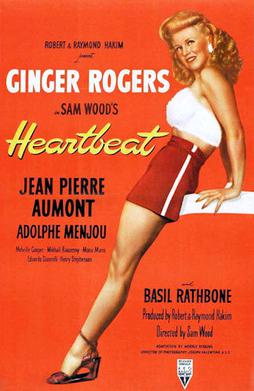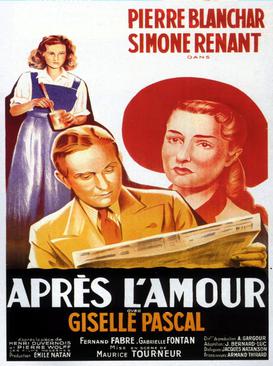Comité de libération du cinéma français was an organization of filmmakers in France created in 1943. The most well-known members are Jacques Becker, Pierre Blanchar, Louis Daquin, Jean Painlevé, and Jean-Paul Le Chanois. Members of this organization made projects for French cinema for after the War. During the German occupation of France in World War II they made films about the Maquis, such as one showing a Maquis camp in Vercors. During the uprising in Paris, they filmed the documentary Journal de la Résistance: La Libération de Paris,. Parts of this movie were used in the newsreel France Libre Actualités.

Pastoral Symphony is a 1946 French drama film directed by Jean Delannoy and starring Michèle Morgan, Pierre Blanchar and Jean Desailly.
The 10th National Board of Review Awards were announced on 15 December 1938.

Arlette Marchal was a French film actress. She appeared in more than 40 films between 1922 and 1951. She was born and died in Paris.

Patrie is a 1946 French historical drama film directed by Louis Daquin and starring Pierre Blanchar, Maria Mauban and Jean Desailly. It was entered into the 1946 Cannes Film Festival. Like the 1917 silent film of the same title it is based on the 1869 play by Victorien Sardou. It was shot at the Epinay Studios in Paris. The film's sets were designed by the art director René Moulaert.

Pierre Blanchar was a French actor. He appeared in more than 50 films between 1922 and 1961. Blanchar was married to actress Marthe Vinot, with whom he had a daughter, actress Dominique Blanchar. He played Napoleon in the 1938 British film A Royal Divorce alongside Ruth Chatterton as Josephine. He later appeared alongside Michèle Morgan in the 1946 film Pastoral Symphony.

A Royal Divorce is a 1938 British historical drama film directed by Jack Raymond and starring Ruth Chatterton, Pierre Blanchar and Frank Cellier. The film portrays the complex relationship between Napoleon I of France and his wife, Josephine Bonaparte from their first meeting until their divorce more than a decade later. It was shot at Denham Studios in Buckinghamshire. The film's sets were designed by the art director David Rawnsley.

Heartbeat is a 1946 American romantic comedy drama film directed by Sam Wood and starring Ginger Rogers, Jean-Pierre Aumont, Adolphe Menjou and Basil Rathbone. It is a direct remake of the French romantic drama Battement de cœur, released in 1940. It was produced by the Hakim Brothers for distribution by RKO Pictures.

My Friend Sainfoin is a French comedy film from 1950, directed by Marc-Gilbert Sauvajon, based on a novel by Paul-Adrien Schaye, and starring Pierre Blanchar. The film features Louis de Funès as guide.

Dominique Blanchar was a stage, television, and film actress from France. She won two Molière Awards in her career.

Crime and Punishment is a 1935 French crime drama film directed by Pierre Chenal and produced by Michel Kagansky starring Harry Baur, Pierre Blanchar and Madeleine Ozeray. It is an adaptation of the 1866 novel of the same name by Fyodor Dostoevsky. The same year a separate American film adaptation was made featuring Peter Lorre.

After Love is a 1948 French drama film directed by Maurice Tourneur and starring Pierre Blanchar, Simone Renant and Giselle Pascal. The film is based on the 1924 play of the same title by Henri Duvernois and Pierre Wolff which has been adapted for the screen a number of times. Tourneur shot it in five weeks and came in under budget. It was the director's penultimate film, followed by Dilemma of Two Angels the same year.
The Thruster (French:L'arriviste) is a 1924 French silent film directed by André Hugon and starring Pierre Blanchar, Jeanne Helbling and Ginette Maddie.
The Wedding March is a 1929 French silent comedy film directed by André Hugon and starring Pierre Blanchar, Louise Lagrange and Paul Guidé.

The Man from Nowhere is a 1937 French drama film directed by Pierre Chenal and starring Pierre Blanchar, Isa Miranda and Catherine Fonteney. It was made at the Cines Studios in Rome, and based on Luigi Pirandello's 1904 novel Il fu Mattia Pascal. A separate Italian-language version of the film was also produced.

Doctor Laennec is a 1949 French historical drama film directed by Maurice Cloche and starring Pierre Blanchar, Saturnin Fabre and Mireille Perrey. It portrays the work of René Laennec, the inventor of the stethoscope.

The Devil in the Bottle is a 1935 French-German drama film directed by Heinz Hilpert, Reinhart Steinbicker and Raoul Ploquin. It stars Käthe von Nagy, Pierre Blanchar and Gina Manès.

The Courier of Lyon is a 1937 French historical drama film directed by Claude Autant-Lara and Maurice Lehmann and starring Pierre Blanchar, Dita Parlo and Jacques Copeau. It is based on the Courrier de Lyon case of 1796. A previous silent film inspired by the story, was released in 1923.

The Little King is a 1933 French drama film directed by Julien Duvivier and starring Robert Lynen, Arlette Marchal and Béatrice Bretty.















